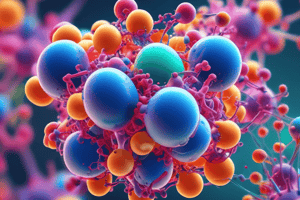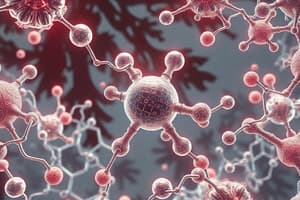Podcast
Questions and Answers
Which type of intermolecular force is the strongest among the ones mentioned in the text?
Which type of intermolecular force is the strongest among the ones mentioned in the text?
- Dipole-dipole interactions
- Hydrogen bonding (correct)
- Ionic interactions
- London dispersion forces
What is the primary reason that London dispersion forces play a crucial role in determining the boiling points of nonpolar covalent compounds?
What is the primary reason that London dispersion forces play a crucial role in determining the boiling points of nonpolar covalent compounds?
- They are the most common intermolecular force involved
- They are the only intermolecular force involved (correct)
- They are the strongest intermolecular force involved
- They are the weakest intermolecular force involved
Which of the following would be expected to have the strongest dipole-dipole interactions?
Which of the following would be expected to have the strongest dipole-dipole interactions?
- CH3Cl
- H2O (correct)
- HCl
- N2
How do intermolecular forces contribute to the stability and structure of proteins and DNA in biological systems?
How do intermolecular forces contribute to the stability and structure of proteins and DNA in biological systems?
Which of the following statements about the relative strengths of the intermolecular forces discussed in the text is correct?
Which of the following statements about the relative strengths of the intermolecular forces discussed in the text is correct?
Which type of intermolecular force requires the most energy to break among hydrogen bonding, dipole-dipole interactions, and London dispersion forces?
Which type of intermolecular force requires the most energy to break among hydrogen bonding, dipole-dipole interactions, and London dispersion forces?
What is the dominant intermolecular force in substances like water, amino acids, and nucleotide bases?
What is the dominant intermolecular force in substances like water, amino acids, and nucleotide bases?
In hydrogen bonding, which atom is typically bonded to hydrogen in small polar molecules?
In hydrogen bonding, which atom is typically bonded to hydrogen in small polar molecules?
What role do intermolecular forces play in affecting the solubility of substances in water?
What role do intermolecular forces play in affecting the solubility of substances in water?
Which intermolecular force is significantly stronger than London dispersion forces?
Which intermolecular force is significantly stronger than London dispersion forces?
Flashcards
Intermolecular Forces
Intermolecular Forces
Forces of attraction between separate molecules.
Hydrogen Bonding
Hydrogen Bonding
Strong dipole-dipole attraction between H and N/O/F.
Dipole-Dipole Interactions
Dipole-Dipole Interactions
Attraction between polar molecules.
London Dispersion Forces
London Dispersion Forces
Weak attraction forces due to temporary electron shifts.
Signup and view all the flashcards
Polar Molecules
Polar Molecules
Molecules with uneven electron distribution, creating dipoles.
Signup and view all the flashcards
Electronegativity
Electronegativity
Tendency of an atom to attract electrons to itself in a chemical bond.
Signup and view all the flashcards
Biological Systems
Biological Systems
Systems that use intermolecular forces for structure & function.
Signup and view all the flashcards
Boiling point
Boiling point
Temperature at which a liquid changes to a vapor.
Signup and view all the flashcards
Melting point
Melting point
Temperature at which a solid changes to liquid.
Signup and view all the flashcards
Van der Waals Forces
Van der Waals Forces
Another name for London Dispersion Forces
Signup and view all the flashcardsStudy Notes
Intermolecular Forces of Attraction
Intermolecular forces, also known as interatomic forces, describe the forces that exist between separate (non-bonded) molecules. These forces play a crucial role in determining various physical and chemical properties of substances, such as boiling points, melting points, solubility in water, and even the structure and function of biological macromolecules. In this article, we'll delve deeper into the four main types of intermolecular forces: hydrogen bonding, dipole-dipole interactions, London dispersion forces, and the roles these forces play in biological systems.
Hydrogen Bonding
One of the strongest types of dipole-dipole interactions is hydrogen bonding. It is unique to small polar molecules, typically involving hydrogen atoms bonded to nitrogen, oxygen, or fluorine atoms. Hydrogen bonds occur when the partially positive hydrogen atom is attracted to the partially negative electronegative atom of another molecule. Hydrogen bonding is significantly stronger than London dispersion forces, making it a dominant force in many organic compounds and biomolecules like water, amino acids, and nucleotide bases.
Hydrogen bonds play a critical role in biological systems, affecting properties like melting points, boiling points, and solubility in water. Compared to other intermolecular forces, hydrogen bonding requires considerable energy to break, leading to higher boiling and melting points for substances that exhibit this type of interaction.
Dipole-Dipole Interactions
Another type of dipole-dipole interaction occurs when polar molecules have permanent dipoles due to differences in electronegativities among their constituent atoms. The partially positively charged part of one molecule is attracted to the partially negatively charged part of another molecule. An example of this is the attraction between chlorine and hydrogen in HCl.
In general, dipole-dipole interactions are stronger than London dispersion forces, but weaker than hydrogen bonding. Nevertheless, they contribute to the overall strength of intermolecular forces and affect physical properties like boiling points and melting points.
London Dispersion Forces
London dispersion forces, also known as van der Waals forces, are a weak attractive force that arises due to temporary variations in electron density distribution around an atom or group of atoms. These forces operate for a very short distance and are strongest for molecules with large numbers of electrons.
Despite being relatively weak compared to other intermolecular forces, London dispersion forces are still significant for understanding the behavior of gases and liquids at high pressures. They play a crucial role in determining the boiling points of nonpolar covalent compounds like methane, ethylene, and carbon dioxide.
Intermolecular Forces in Biological Systems
Biological systems utilize various types of intermolecular forces to maintain structure, function, and stability. For instance, hydrophobic regions containing only hydrocarbons are attracted to other nonpolar regions by London dispersion forces, while hydrophilic regions consisting of atoms like oxygen or nitrogen are involved in dipole-dipole and hydrogen bonding interactions. These forces contribute to the folding patterns and stability of proteins, as well as the formation of DNA double helix structures. In addition, ionic interactions between metal cations and carboxylic acid anions or ammonium ions from amino groups can further enhance the stability of macromolecules.
Studying That Suits You
Use AI to generate personalized quizzes and flashcards to suit your learning preferences.





